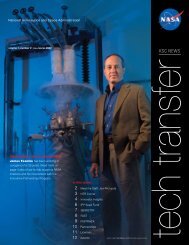2006-2007 - Kennedy Space Center Technology Transfer Office
2006-2007 - Kennedy Space Center Technology Transfer Office
2006-2007 - Kennedy Space Center Technology Transfer Office
- No tags were found...
Create successful ePaper yourself
Turn your PDF publications into a flip-book with our unique Google optimized e-Paper software.
Photocatalytic Coatings for Exploration and <strong>Space</strong>port Design<strong>2006</strong> <strong>Center</strong> Director’s Discretionary Fund ProjectCorrosionControlThis project developed self-cleaning photocatalytic coatings that remove contaminationwithout human intervention. The coatings chemically remove organic contaminants and leaveno residue. The photocatalyst will not negatively affect other coating properties, especiallycorrosion resistance.Titanium dioxide, TiO 2, is an extremely popular photocatalyst because of its chemical stability,nontoxicity, and low cost. TiO 2is commonly used in the photocatalytic oxidation of organic matteror pollutants in the gas and liquid phases. However, TiO 2does have some drawbacks. It has limitedlight absorption because of its large band-gap and suffers from a photonic efficiency of less than10 percent for organic degradation. Dopants can lower the band-gap and improve efficiency. Sincethe photocatalytically active form of TiO 2is a nanocrystalline powder, it can be difficult to make arobust coating with enough catalyst loading to be effective.Photocatalysts become active when certain light energy is absorbed. When photons with an energygreater than the band-gap, E g, (wavelengths shorter than 400 nm) impinge upon the surface of theTiO 2, an electron-hole pair is formed (Figure 1). The electron-hole pair oxidizes adsorbed substanceseither directly or via reactive intermediates that form on the surface, such as hydroxyl radicals (OH·)or superoxide ions (O 2–).Several factors can influence the band-gap energy of TiO 2, two of which are crystal structure andimpurities. TiO 2exists as three crystal structures—brookite, anatase, and rutile—that can becontrolled via heat treatment. Anatase is the most photocatalytically active crystal form of TiO 2.Doping TiO 2with impurities can alter its band-gap energy, as well as its effectiveness as a catalyst.Depending on their size, dopant atoms can occupy either the substitutional or interstitial latticepositions. Atoms that are relatively large will assume the interstitial positions and create a muchgreater energy disturbance in the crystal than will smaller atoms that take on the substitutionalpositions. This energy disturbance narrows the band-gap and thus allows photons with longerwavelengths and smaller energies (such as those in the visible-light spectrum) to create electron-holepairs.Raman spectroscopy was performed for the purpose of determining the crystal structure and thedegree of crystallinity of the TiO 2particles. Reflectance measurements indicated the wavelengthsof light absorbed by the different catalysts. Reflectance is inversely proportional to absorbance andcan help approximate the band-gap. The wavelength where the percentage of reflectance beginsto decrease approximates the band-gap. For pure TiO 2, only the sample heated to 600 °C exhibitsdifferent spectral behavior from the others. Its rutile crystal structure ended its absorbance near awavelength of 460 nm instead of the 435-nm wavelength characteristic of the other samples in theanatase phase.For the catalysis evaluation, 20 µL of 0.2-mg/mL Rhodamine B dye in ethanol was added to10-mg samples of the catalyst. Half of the prepared samples were exposed to ultraviolet (UV)radiation (from an F8T5/BLB fluorescent light with peak emission at 365 nm) for 24 hours, whilethe other half were kept in the dark. Upon completion of the UV test, the addition of 5 mL of waterdissolved the remaining dye. The absorbance of the dye, measured with an HP spectrophotometer,between 450 nm and 615 nm, revealed the amount of dye remaining after exposure. The effectivenessof each catalyst was determined by the comparison of the amount of absorbance of the dye remainingin the samples with the initial absorbance of the dye alone. All measurements were made in triplicate.Figure 2 shows results for the cleaning efficiency of pure TiO 2made with three different proceduresand different heat treatments. Procedure 3 with a heat treatment at 400 °C performed the best. Ingeneral for all the doped catalysts, Procedure 3 with the same heat treatment performed the best.14 <strong>Space</strong>port Structures and Materials













